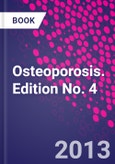Table of Contents
IntroductionThe Bone Organ System: Form and Function
The Nature of Osteoporosis
The Economics of Osteoporosis
Reflections on Osteoporosis
Skeletal Heterogeneity and the Purposes of Bone Remodeling: Implications for the
Understanding of Osteoporosis
Basic Science/Bone Biology
Osteoblast Biology
Osteoclast Biology
Osteocytes
The Regulatory Role of Matrix Proteins in Mineralization of Bone
Development of the Skeleton
Mouse Genetics as a Tool to Study Bone Development and Physiology
Parathyroid Hormone and Parathyroid Hormone-Related Protein
Vitamin D: Biology, Action, and Clinical Implications
Regulation of Bone Cell Function by Estrogens
Androgens and Skeletal Biology: Basic Mechanisms
Phosphatonins
Wnt Signaling in Bone
Cytokines and Bone Remodeling
Skeletal Growth Factors
Intercellular Communication During Bone Remodeling
Structural and Biomechanics
Skeletal Development: Mechanical Consequences of Growth, Aging and Disease
Inhibition of Osteoporosis by Biophysical Intervention
Biomechanics of Age-Related Fractures
Bone Quality
Epidemiology & Risk Factors
Epidemiologic Methods in Studies of Osteoporosis
Race, Ethnicity and Osteoporosis
The Study of Osteoporotic Fractures (SOF): Major Findings and Contributions
Bone Mineral Acquisition in Utero and During Infancy and Childhood
Bone Acquisition in Adolescence
Genetic Determinants of Osteoporosis
Nutrition and Risk for Osteoporosis
Physical Activity in Prev
Authors
Robert Marcus Professor Emeritus, Department of Medicine, Stanford University School of Medicine, CA, USA. Dr. Marcus is Professor-Emeritus, Stanford University, where he served on the full-time medical faculty for almost 25 years, before joining the Emeritus faculty in 2001. At Stanford, he was located at the Veterans Affairs Medical Center, Palo Alto California, where he served as Director of the Aging Study Unit of the Geriatrics Research, Education, & Clinical Center from 1982-2001. Dr. Marcus enjoyed a long career as a clinical investigator in the fields of bone and mineral metabolism and osteoporosis medicine. His own research interests included diagnosis and therapy of primary hyperpara-thyroidism, interactions of the parathyroid-vitamin D axis with estrogen, age-related changes in the growth hormone-IGF axis, effects of growth hormone replacement for older men and women, metabolic and musculoskeletal effects of resistance exercise in older men and women, adolescent bone acquisition, and osteoporosis therapeutics. Dr. Marcus' laboratory was a study site for many of the pivotal clinical trials in the osteoporosis field. These include the NIH Post-menopausal Estrogen/Progestin Interventions Trial (PEPI), Merck's Fracture Intervention Trial (FIT), Lilly's Multiple Outcomes of Raloxifene Intervention (MORE), and Lilly's registration trial of recombinant PTH(1-34) in the treatment of postmenopausal women with osteoporosis. In 2001. Dr. Marcus joined the US Affiliate of Eli Lilly & Company to support Lilly's program in Osteoporosis and Skeletal Medicine. From 2003 until his retirement from Lilly in 2008, Dr. Marcus was the lead physician for the Forteo team at Lilly. He has published more than 150 research papers, editorials, and reviews. Dr. Marcus served as President of the American Society for Bone & Mineral Research in 2000-2001. David W. Dempster Professor of Clinical Pathology and Cell Biology, Columbia University School of Medicine; Director Emeritus, Regional Bone Center, Helen Hayes Hospital, New York, NY, USA. David W. Dempster, PhD, is Professor of Clinical Pathology and Cell Biology at Columbia University in New York. He obtained his PhD from the University of Glasgow in Scotland and completed postdoctoral studies in Switzerland and France. Dr. Dempster is a Past President of the International Society of Bone Morphometry and a member of the Scientific Advisory Council of the National Osteoporosis Foundation. He is also a Fellow of the Royal Microscopical Society. Dr. Dempster's iconic micrographs of osteoporotic bone have been widely reproduced in the scientific and popular press, including being displayed at the Smithsonian Institution in Washington, DC. Dr. Dempster is an Associate Editor of Osteoporosis International, and serves on the editorial boards of the Journal of Bone and Mineral Research, Bone and the Journal of Clinical Densitometry. His research studies have been continuously supported by the National Institutes of Health for the past 25 years. Dr. Dempster has published over 200 research papers on the pathophysiology and treatment of bone disese. Jane A. Cauley Distinguished Professor of Epidemiology, University of Pittsburgh Graduate School of Public Health, Pittsburgh, PA, United States. Dr. Cauley, DrPH, is a Distinguished Professor and Executive Vice Chair, Department of Epidemiology, Graduate School of Public Health (GSPH), University of Pittsburgh (Pennsylvania). Her primary research interest is the epidemiology of osteoporosis especially the large worldwide ethnic and geographic variability in fracture, osteoporosis screening and treatment, risk factors for fractures and the consequences of osteoporosis in both men and women. Her research has also focused on women's health and aging, falls, the interaction between endogenous and exogenous hormones, risk factors, and disease outcomes. She was principal investigator for several large cohort studies including the Study of Osteoporotic Fractures (SOF) and the Osteoporotic Fractures in Men (MrOS) study. She is a co-investigator for the Study of Women's Health Across the Nation (SWAN) with particular emphases on skeletal health and physical function and body composition changes, novel measures of hip strength and the trabecular bone score across menopause. She initiated breast cancer follow-up in SOF and was the first to demonstrate an association between bone mineral density (BMD) and breast cancer, suggesting that BMD could be used as a cumulative measure of lifetime exposure to estrogen.Dr. Cauley has authored more than 800 papers for scientific journals and 28, book chapters. She co-edited a book entitled the Epidemiology of Aging, published in 2012. David Feldman Stanford University School of Medicine, Stanford, California, USA.








